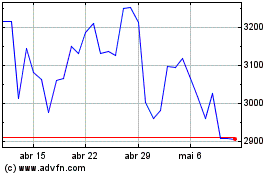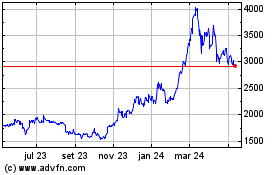Changing Tides: Restaking Takes Center Stage In Ethereum (ETH) Staking Landscape
10 Abril 2024 - 7:00PM
NEWSBTC
In recent months, the Ethereum staking landscape has witnessed
significant transformations, prompting a shift in investor
preferences and reshaping the sector’s dynamics. According to
on-chain data researcher and strategist at 21Shares, Tom Wan, key
metrics indicate a notable change in the approach towards Ethereum
staking, with restaking gaining prominence as a preferred method.
Ethereum Restaking Landscape Wan’s observations, shared on the
social media platform X (formerly Twitter), highlight a steady
increase in ETH staking deposits from restaking, rising from 10% to
60% since 2024. Restaking can be accomplished in two primary
ways: through ETH natively restaked or by utilizing a liquid
staking token (LST). By staking their ETH, users secure additional
applications known as Actively Validated Services (AVS), which
yield additional staking rewards. A significant player in the
staking landscape is EigenLayer, which has emerged as the
second-largest decentralized finance (DeFi) protocol on the
Ethereum network. Related Reading: Are The Odds In Bitcoin
Bulls Favor? These Analysts Forecast BTC’s Future EigenLayer has
achieved a significant milestone with the release of EigenDA, its
data availability Actively Validated Service (AVS), on the
mainnet. According to a research report by Kairos, this
launch marks the beginning of a new era in restaking, where liquid
restaking tokens (LRTs) will become the dominant way for restakers
to do business. Currently, 73% of all deposits on EigenLayer
are made through liquid restaking tokens. The report highlights
that the growth rate of LRT deposits has been significant,
increasing by over 13,800% in less than four months, from
approximately $71.74 million on December 1, 2023, to $10 billion on
April 9, 2024, demonstrating the growing confidence in EigenLayer’s
approach to restaking and contributing to the shifting tides in
Ethereum’s staking landscape. According to Wan, the rise of
liquid restaking protocols has also contributed to a decline in the
dominance of Lido (LDO), a staking service solution for Solana
(SOL), Ethereum, and Terra (LUNC). On the other hand, Etherfi
has emerged as the second-largest stETH withdrawer, with 108,000
stETH withdrawn through the first quarter of 2024. This trend
exemplifies the increasing popularity of liquid restaking
protocols, allowing stakers to withdraw and actively utilize their
staked assets while still earning rewards. Ether.fi Set To Surpass
Binance In ETH Staking Data provided by Wan also shows a decline in
the dominance of centralized exchanges (CEXs) in ETH staking. Since
2024, CEXs have seen their share of staking decline from 29.7% to
25.8%, a significant drop of 3.7%. As a result, the
decentralized staking provider Kiln Finance has surpassed Binance
and become the third-largest entity in terms of ETH staking. With
Ether.fi poised to follow suit, it is expected to surpass Binance’s
position shortly, according to the researcher. Related
Reading: Crypto Experts Predict Massive Price Surge For XRP Price,
Is $20 Possible? In short, these developments signify a paradigm
shift in the Ethereum staking landscape, with re-staking
methodologies gaining traction and decentralized protocols like
EigenLayer and Ether.fi challenging the dominance of established
players. As of this writing, ETH’s price stands at $3,500. It
has been exhibiting a sideways trading pattern over the past 24
hours, remaining relatively stable compared to yesterday. Featured
image from Shutterstock, chart from TradingView.com
stETH (COIN:STETHUSD)
Gráfico Histórico do Ativo
De Out 2024 até Nov 2024

stETH (COIN:STETHUSD)
Gráfico Histórico do Ativo
De Nov 2023 até Nov 2024
